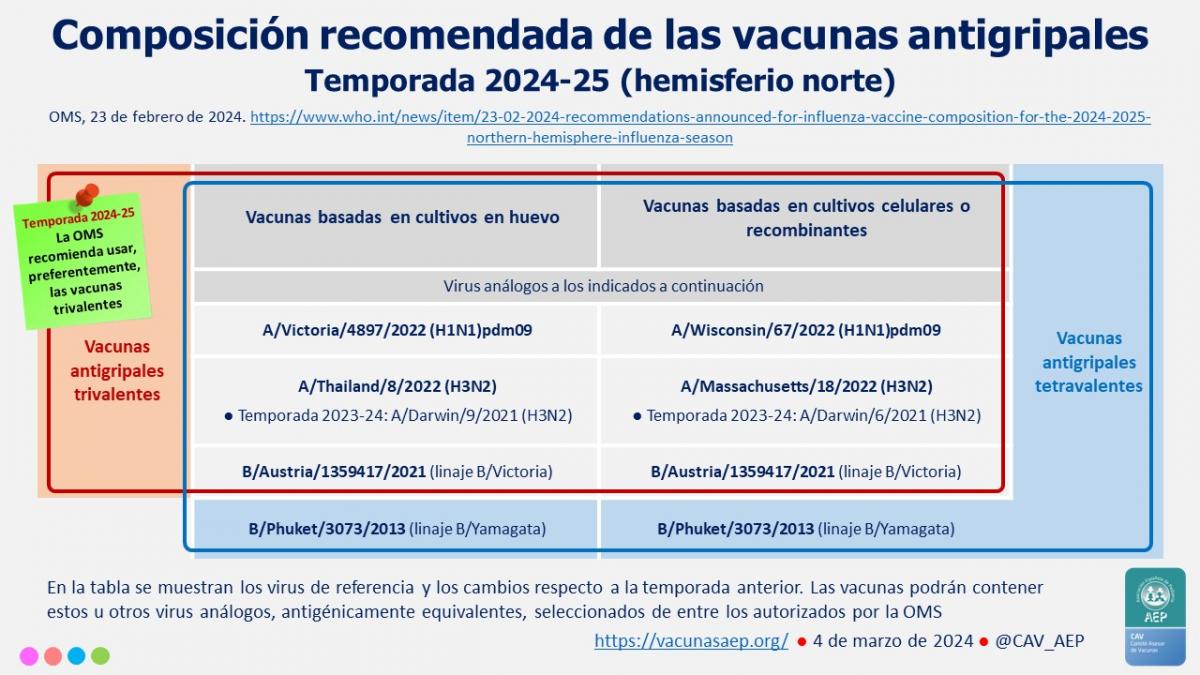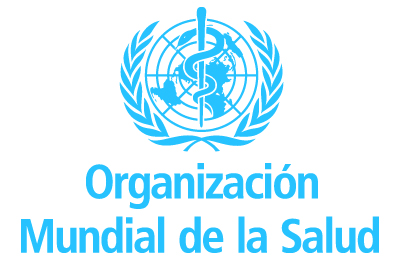Composition of influenza vaccines for the next season 2024-2025.


| Content |
|---|
| ● Introduction (see). ● Composition of influenza vaccines in the northern hemisphere for the 2024–2025 season. (see) | Reference documents | Recommended composition (see) | Other documents (see). ● General questions, questions and answers from WHO (see). ● The predominant use of trivalent vaccines poses challenges for vaccine manufacturers, regulators and public health authorities (see). ● Additional information on this website, links and recommended links (see). |
| In a nutshell |
|---|
| ● WHO has published its recommendations for the composition of influenza vaccines in the northern hemisphere for the upcoming 2024-2025 season. ● WHO recommends the preferred use of trivalent vaccines excluding the Yamagata lineage component of influenza B virus. ● Since March 2020, there have been no confirmed cases of influenza B/Yamagata lineage viruses detected. ● The WHO decision, supported by the FDA, is an important commitment facing great challenges and public health challenges. |
-ooo-
Introduction
Every year, WHO publishes its recommendations on the composition of influenza vaccines for the next season. In February for the northern hemisphere and in August or September for the southern hemisphere.
The recommendations are based on numerous sources of information: epidemiological surveillance of influenza, antigenic and genetic characteristics of identified viruses, serological studies, data on the effectiveness of vaccines, resistance to antiviral drugs, and others. This information is displayed on the website Global Influenza Surveillance and Response System (GISGS).
Discussions by expert groups convened by WHO resulted in recommendations for the composition of influenza vaccines in the northern hemisphere for the next 2024–2025 season, which are discussed below. The recommended vaccine mix for the northern hemisphere in 2024-2025 is the same as that recommended for the southern hemisphere in 2024 (flu season April to August 2024).
(To come back to the beginning)
Composition of influenza vaccines in the northern hemisphere for the 2024-2025 season.
 Reference documents
Reference documents
Next season WHO recommends the use of trivalent vaccinesleaving aside the Yamagata lineage component of influenza B virus. Isolation of this virus has not been confirmed since March 2020, so it is assumed there is no need to include it.
(To come back to the beginning)
Recommended composition
WHO recommends that trivalent vaccines for use in the 2024–2025 Northern Hemisphere influenza season. contain the following (see image above):
- Egg-based vaccines:
- Virus similar to A/Victoria/4897/2022 (H1N1)pdm09.
- Virus similar to A/Thailand/8/2022 (H3N2).
- Virus similar to B/Austria/1359417/2021 (B/Victoria lineage).
- Vaccines based on cell cultures or recombinants:
- Virus similar to A/Wisconsin/67/2022 (H1N1)pdm09.
- Virus similar to A/Massachusetts/18/2022 (H3N2).
- Virus similar to B/Austria/1359417/2021 (B/Victoria lineage).
For quadrivalent vaccinesIn countries choosing to store them on egg, cell culture or recombinant basis, WHO recommends including the following viruses as a component of the B/Yamagata lineage: virus similar to B/Phuket/3073/2013 (B/Yamagata lineage).
The WHO notes that next season’s vaccines should contain viruses that are similar from an antigenic point of view to those mentioned as reference ones. To do this, WHO selects and authorizes a set of viral strains with similar hemagglutinin so that they can be used by different manufacturers.
(To come back to the beginning)
Other documents
The WHO recommendations are accompanied by the following Additional documents:
(To come back to the beginning)
General questions, questions and answers from WHO
WHO answers to frequently asked questions include the following.
How are WHO recommendations on the composition of influenza vaccines developed?
The WHO GISRS consists of 151 influenza reference centers in 125 countries, 7 collaborating centers and 16 reference laboratories worldwide. GISRS collects and analyzes data from various sources, such as those mentioned above, including the availability of reference strains for vaccine production.
What does the expression “similar virus” mean in a vaccine?
The recommended vaccine viruses represent an antigenic group of viruses that are expected to be widespread in the upcoming influenza season. Several candidate viral strains are often available that have HA antigens from other viruses that are antigenically similar to the recommended vaccine viruses. The term “similar virus” is included to allow the use of other bioequivalent strains for vaccine production.
Are the B/Yamagata lineage influenza viruses extinct?
Since March 2020, there have been no WHO-confirmed detections of influenza B/Yamagata lineage viruses. Recent reports of detection of B/Yamagata have not been confirmed or identified as live attenuated vaccine viruses.
Although it cannot be certain that the B/Yamagata lineage viruses are extinct, they are unlikely to cause outbreaks in the next season. On the other hand, there is a theoretical risk of spread associated with the use of this virus in the production of inactivated or attenuated vaccines, so WHO recommends that strains of this virus be eliminated from vaccines in use as soon as possible. .
(To come back to the beginning)
The predominant use of trivalent vaccines poses challenges for vaccine manufacturers, regulators, and public health authorities.
 It would seem that returning to trivalent vaccines is a simple solution: “why vaccinate something that doesn’t exist”, “removing a component from vaccines is as easy as removing a component from a smoothie made from various fruits,” arguments are put forward. which reflect an approach that is too simple and far from complex reality. Against, This decision faces corresponding difficulties and has very serious consequences. this must be taken into account. It is not enough to say that it is “no longer necessary” to include the Yamagata component in vaccines, and this is largely true (Editorial, Lancet Infect Dis 2023; Wu KJ, The Atlantic 2024; Branswell H, STAT 2024).
It would seem that returning to trivalent vaccines is a simple solution: “why vaccinate something that doesn’t exist”, “removing a component from vaccines is as easy as removing a component from a smoothie made from various fruits,” arguments are put forward. which reflect an approach that is too simple and far from complex reality. Against, This decision faces corresponding difficulties and has very serious consequences. this must be taken into account. It is not enough to say that it is “no longer necessary” to include the Yamagata component in vaccines, and this is largely true (Editorial, Lancet Infect Dis 2023; Wu KJ, The Atlantic 2024; Branswell H, STAT 2024).
Until 2012, only trivalent influenza vaccines (two influenza A virus components and one influenza B virus component) were used. The circulation of variants of influenza B virus led to the use of quadrivalent vaccines (two components of influenza A virus and two more components of influenza B virus) in the 2013 season in the southern hemisphere. Since then, the use of these vaccines has only increased worldwide (for example, in the United States, only quadrivalent vaccines were used after the 2021-2022 campaign).
When the WHO again recommended trivalent vaccines (excluding the Yamagata lineage component of influenza B) in its recommendations for the 2024 southern hemisphere influenza season in September 2023, vaccine manufacturers said they may have trouble adapting their production systems. meet regulatory requirements for new trivalent vaccines in a timely manner (Express Pharma, October 2023). However, these were not the only difficulties that arose, as they also arose in other areas.
At that time, the expert committee advising the US FDA (VRBPAC) was in full agreement with the WHO and joined in the recommendation to switch back to trivalent vaccines.”As soon as possible(Avalere, October 2023). However, they explained and discussed that this solution faces different challenges in different areas (VRBPAC, FDA, October 5, 2023; Editorial, Lancet Infect Dis 2023; Wu KJ, The Atlantic 2024; Branswell H, STAT 2024):
- V vaccine production, as they have to restart vaccine production processes that have all but stopped. This situation is expected to affect over 350 inactive licenses that will need to be updated (new efficacy studies, immunogenicity assays, etc.). Vaccine makers (Seqirus, GSK and world leading manufacturer Sanofi) said they were “fully committed” to WHO recommendations, although they said it would take some time.
- V research on new vaccines, such as universal influenza vaccines, mRNA vaccines, combination covid and influenza vaccines, etc., were in development, which suggested a horizon with the Yamagata lineage B virus. These investigations will have to be refocused away from the Yamagata component, which is costly and will delay results.
- For regulatory authoritieswhich will have to evaluate and, if necessary, approve new products, procedures that are extremely complex when they concern new products.
- And for public health authorities, which will: a) determine the pace of return to preferential or exclusive use of trivalent vaccines in accordance with their specific conditions; b) weigh the risks of maintaining circulation of influenza viruses in the Yamagata line in the production processes of inactivated vaccines and, above all, quadrivalent attenuated vaccines that continue to be administered; c) accept the risk of re-emergence of this virus and the consequences of exclusive use of trivalent vaccines to protect the population from a variety of influenza viruses; and, among other things, d) the need for a very strict global virological surveillance plan.
Consequently, manufacturers, regulators, and relevant experts and authorities are expected to make appropriate decisions in the coming weeks (time is urgent as the availability of vaccines next fall) to guide the vaccine rollout. trivalent influenza vaccines, taking into account general WHO recommendations and the specific conditions of each country. For its part, the US FDA has already stated that it will discuss these issues as early as Tuesday, March 5, this week.
(To come back to the beginning)
-ooo-
More information on this website
Links and recommended links
- Avalere, October 5, 2023 Removal of the influenza B strain may affect future influenza vaccines.
- Branswell H. WHO and drug regulators want to reformulate flu vaccine. This is easier said than done. STAT, January 16, 2024
- Express Pharma, October 25, 2023. WHO trivalent recommendations will change the global flu vaccine market: GlobalData with recommendations for the northern hemisphere is expected to follow suit.
- FDA, US Vaccines and Related Biological Products Advisory Committee, October 5, 2023, meeting announcement, October 5, 2023.
- Lancet Publishing House. Flu Vaccine Shake. Lancet Infectious Dis. 2023;23(12):1323.
- WHO, 23 February 2024. Press release. Influenza vaccine composition recommendations for the 2024-2025 northern hemisphere influenza season have been announced.
- WHO, 23 February 2024. Recommended influenza virus vaccine composition for use during the 2024–2025 northern hemisphere influenza season. Details of recommendations. ►Comment: CIDRAP, February 23, 2024
- WHO, 23 February 2024 Questions and answers. Recommended influenza virus vaccine composition for use during the 2024–2025 northern hemisphere influenza season. and development of vaccine virus candidates for pandemic preparedness.
- WHO, February 2024. Genetic and antigenic characteristics of zoonotic influenza A viruses and development of candidate vaccine viruses for pandemic preparedness.
- WHO, 29 September 2023. Recommended composition of influenza virus vaccines for use in the 2024 southern hemisphere influenza season. ►Comment: CIDRAP, 29 September 2023.
- Wu K.J. Flu shots should stop fighting “something that doesn’t exist.” One type of influenza virus has been gone for so long that there is no point in getting vaccinated against it. Atlantic, February 5, 2024
(To come back to the beginning)
